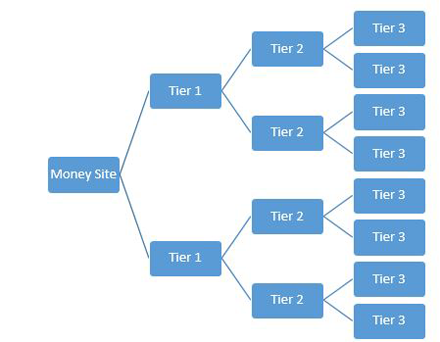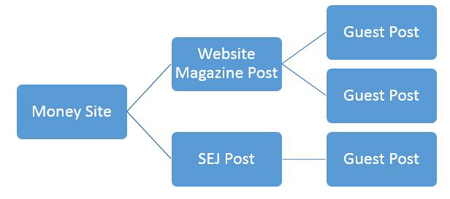Why Your Tiered Link Building is Ineffective

For the past couple of years, tiered link building has been an effective means of boost search rankings. As with several other types of link building, the effectiveness of this strategy is greatly reduced when you don't take the time to do it properly.
Today we are going to discuss how to build tiered links in such a way that you will actually see positive results.
What Was Tiered Link Building?
In 2012 Matthew Woodward shared a great video series on YouTube that provided step-by-step instructions for tiered link building, although now outdated, the series gave many people new to link building a look at how to step outside of traditional methods and try something new.
Here is what the old method of tiered link building looked like.

Your "money site" is the website or page you are trying to rank.
Tier 1
Tier 1 properties were generally filled with hand spun content or scraped and spun content, with a focus on uniqueness over readability. As opposed to using specific keywords in generating content in tier one, many would use a broad topic. If your main site is about kitchen countertops, your tier 1 sites may be about the more broad topic of home improvement. The majority of tier 1 links were made using Web 2.0 properties and article submissions. The purpose was to create contextual links back to a site from a somewhat related page.
Tier 2
Tier 2 content was almost always auto scraped and spun content. Again, the topic would be broader in nature. Scraping content with a keyword like "construction" would be considered an acceptable practice at the time. In addition to contextual links, you would see a lot of do-follow comments, profile links, and a handful of other spam-tastic links.
Tier 3
Tier 3 links were a spam free-for-all. The main purpose of the third tier was to get tier 2 indexed so that in turn, tier 1 links would be indexed. Tools like GSA Search Engine Ranker, Scrapebox, Ultimate Demon, and SeNuke well used to do the heavy lifting of the third tier.
What Was Wrong with Tiered Links?
As many of you know, Google uses an algorithm with more than 200 known ranking factors. Each factor is weighted and therefore has a varying impact on your overall ranking. Contextual links are in general the best type of links to acquire.
The theory behind tiered link building was that you could consolidate "link juice" from a high volume of low-quality sites and pass the cumulative "link juice" through contextual links in tier 2 and tier 1. The goal of this was to quickly and easily increase the power of the tiers containing contextual links to your money site. The reason for the top tier sites was to shape the topical relevance of the consolidated "link juice."
Put more simply, the theory was you could point links from a dog grooming site to a site covering a topic related to your money site and then Google would give more value to the link because it was relevant.
What the theory failed to take into account was that negative metrics would be passed along the same as positive. That means that the incredibly spammy links in tier 3 and two can negatively affect your website.
After numerous updates from Google, including some that specifically targeted spammy tiered link building, the old way has less impact and increased the likelihood of hurting your money site. As Google evolved though, so has tiered link building.
White Hat Tiered Link Building
A year or so ago, white hat tiered link building became a topic of discussion among many. The theory behind this is to boost quality links with other quality links. Here is an example.

What makes this method even more effective is the fact that many sites are much more willing to link out to another authority site than back to your site in the context of a post. If you look at it from a marketing standpoint, you can still see the value of this method. You are leading people through a learning process and you are the teacher for most of the journey.
In addition, exposing a reader to your content on several authority sites will build trust with them, sometimes unknowingly.
The verdict, tiered white hat link building is a winner. You should also note that spam links are not part of this strategy, so the negative effects of the former style of tiered linking are not there either.
Gray Hat Tiered Link Building
For those of you who dabble in the gray or black hat link building tactics, tiered link building is likely part of your arsenal as well. If you intentionally build links to a website, you are violating Google's guidelines and participating in gray hat link building.
If you are curious as to how tiered links can be built in a gray hat manner, here is what seems to be working at the moment.
Tier 1
Tier 1 is generally made up of private blog network sites. These sites generally contain no less than 10 unique and handwritten articles that are focused around a specific keyword or topic. If your main website was about agility training for dogs, your tier 1 sites would also be focused on agility training for dogs.
Tier 2
Tier 2 links come primarily from Web 2.0 sites and lesser-quality PBN (private blog network) sites. The themes of these sites are again very specific in nature. Continuing with the dog training theme, you would make the tier 2 sites about agility training for specific breeds of dogs. Tier 2 sites should also contain unique and handwritten content.
Tier 3
Tier 3 links are generally no longer built by the thousands from blog comments and other spam sites. Buying links from a blog network that is themed is now the primary method being used to power up the tiers and assist with indexation. Sometimes people will even buy a post on a blog network and link that post to a couple of the tier 2 sites, sending some "link juice" through both of them.
Including Social Signals
There is still an ongoing debate about the impact of social signals on SEO. Even if you are skeptical about the ranking impact, you cannot argue with the fact that having social signals makes a site appear to be active and popular. The one thing that many self-built tiered link structures are missing is social signals. When setting up your sites, take the extra time to set up a few associated social profiles to go along with each of them. At minimum, set up an RSS feed so that those profiles receive updates to them. In addition, install plugins on your sites that will share your posts to those same accounts. This will at least make your sites look somewhat active and legitimate.
Final Thoughts
As Google continues to improve their understanding of sites and linking structures, the methods being used must keep pace or lost rankings and penalties are going to happen. For the majority of you, outreach link building is the best road to follow. For those of you who understand the risk vs. reward of tiered link building, it may be a method capable of providing an ROI for your business.
What are your thoughts on Tiered Link Building?









